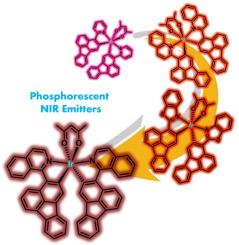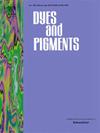Phosphorescent cyclometalated Ir(III) complexes with fluoranthene unit and their near-infrared (NIR) OLEDs showing NIR% higher than 99 %
IF 4.1
3区 工程技术
Q2 CHEMISTRY, APPLIED
引用次数: 0
Abstract
With the aim to design and synthesize cyclometalated Ir(III) complexes with near-infrared (NIR) emission, a series of ppy-type ligands with fluoranthene unit have been synthesized bearing different aromatic nitrogen heterocycles of isoquinoline, quinoline, pyridine and benzo [d]thiazole. With these organic ligands, four [Ir (ppy)2 (acac)] complexes are prepared named as IrFTIQ, IrFTQL, IrFTPY and IrFTBZ. In solution, IrFTIQ can emit NIR phosphorescence at 738 nm, while IrFTQL (ca. 692 nm), IrFTPY (ca. 670 nm) and IrFTBZ (ca. 690 nm) are typical deep-red emitters. It should be noted that all these fluoranthene-based cyclometalated Ir(III) complexes show good electrochemical stability indicated by their reversible redox procedures. When doped in the emission layer of OLEDs, IrFTIQ and IrFTBZ can furnish NIR electroluminescence (EL) at 748 nm and 700 nm, respectively, while the devices with IrFTPY as emitter can furnish deep-red EL. Critically, the optimized OLED doped with IrFTIQ can achieve maximum external quantum efficiency (EQE) as high as 5.01 % and a radiance up to 6284 mW Sr−1 m−2. Critically, the NIR OLEDs based on IrFTIQ can furnish EL with NIR component (NIR%) of a total spectrum > 99 %. All these encouraging results definitely demonstrate the effectiveness of our molecular design strategy for the new-type Ir(III) NIR phosphorescent complexes and the great potential of the fluoranthene group in developing high-performance Ir-based NIR phosphors for OLEDs.

具有荧蒽单元的磷光环甲基化铱(III)配合物及其近红外 (NIR) 有机发光二极管(NIR%高于 99
为了设计和合成具有近红外发射的环甲基化 Ir(III) 配合物,我们合成了一系列带有荧蒽单元的PY 型配体,这些配体含有异喹啉、喹啉、吡啶和苯并 [d]噻唑等不同的芳香氮杂环。利用这些有机配体制备了四种[Ir (ppy)2 (acac)] 复合物,分别命名为 IrFTIQ、IrFTQL、IrFTPY 和 IrFTBZ。在溶液中,IrFTIQ 可以发出 738 纳米的近红外磷光,而 IrFTQL(约 692 纳米)、IrFTPY(约 670 纳米)和 IrFTBZ(约 690 纳米)则是典型的深红色发光体。值得注意的是,所有这些基于荧蒽的环金属化 Ir(III) 复合物都具有良好的电化学稳定性,其可逆氧化还原过程表明了这一点。当掺杂到有机发光二极管的发射层时,IrFTIQ 和 IrFTBZ 可分别在 748 纳米和 700 纳米波长处发出近红外电致发光(EL),而以 IrFTPY 作为发射体的器件则可发出深红色 EL。重要的是,掺杂了 IrFTIQ 的优化 OLED 可实现高达 5.01 % 的最大外部量子效率 (EQE),辐射量高达 6284 mW Sr-1 m-2。更重要的是,基于 IrFTIQ 的近红外有机发光二极管可以提供总光谱为 99% 的近红外成分(NIR%)电致发光。所有这些令人鼓舞的结果无疑证明了我们的新型 Ir(III)近红外磷光配合物分子设计策略的有效性,以及荧蒽基团在开发用于 OLED 的高性能 Ir 基近红外荧光粉方面的巨大潜力。
本文章由计算机程序翻译,如有差异,请以英文原文为准。
求助全文
约1分钟内获得全文
求助全文
来源期刊

Dyes and Pigments
工程技术-材料科学:纺织
CiteScore
8.20
自引率
13.30%
发文量
933
审稿时长
33 days
期刊介绍:
Dyes and Pigments covers the scientific and technical aspects of the chemistry and physics of dyes, pigments and their intermediates. Emphasis is placed on the properties of the colouring matters themselves rather than on their applications or the system in which they may be applied.
Thus the journal accepts research and review papers on the synthesis of dyes, pigments and intermediates, their physical or chemical properties, e.g. spectroscopic, surface, solution or solid state characteristics, the physical aspects of their preparation, e.g. precipitation, nucleation and growth, crystal formation, liquid crystalline characteristics, their photochemical, ecological or biological properties and the relationship between colour and chemical constitution. However, papers are considered which deal with the more fundamental aspects of colourant application and of the interactions of colourants with substrates or media.
The journal will interest a wide variety of workers in a range of disciplines whose work involves dyes, pigments and their intermediates, and provides a platform for investigators with common interests but diverse fields of activity such as cosmetics, reprographics, dye and pigment synthesis, medical research, polymers, etc.
 求助内容:
求助内容: 应助结果提醒方式:
应助结果提醒方式:


